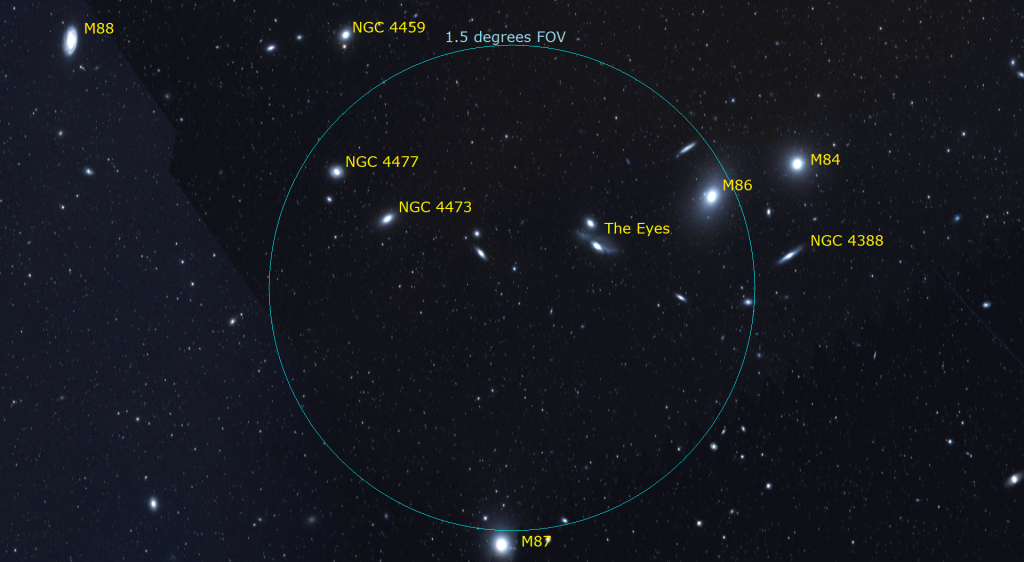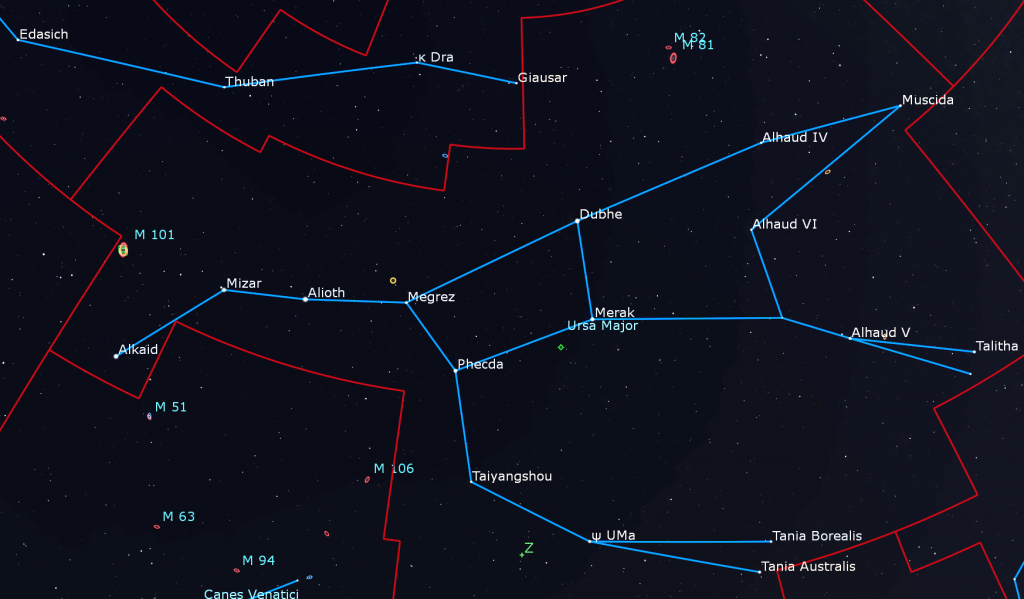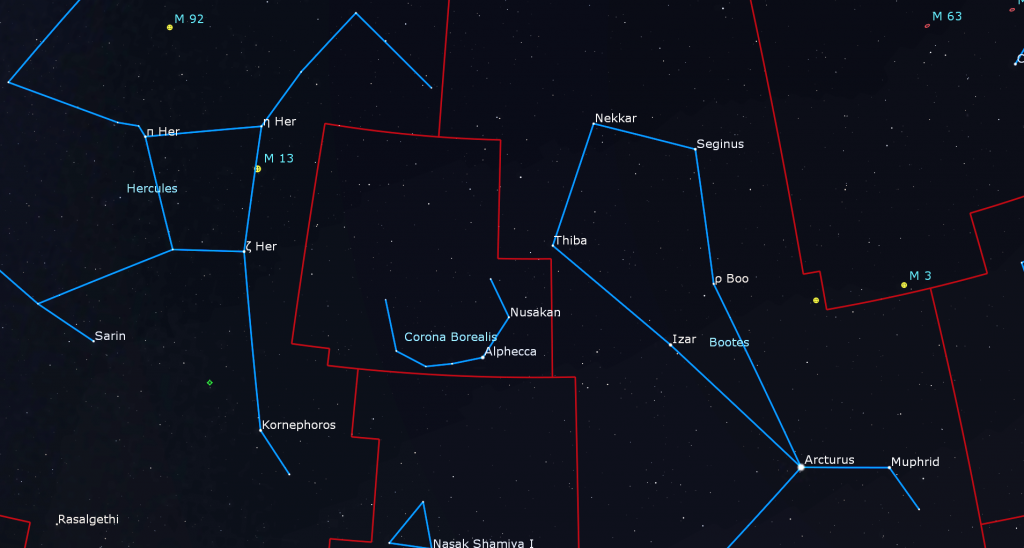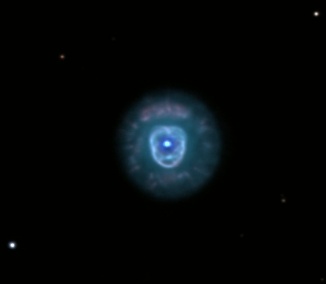The Mid-spring Morning Moon Joins Gas Giants, a Minor Meteor Shower, and an Inner Planets Dance Begins!

This image of the globular star cluster Messier 3 in Canes Venatici was captured by Adam Block at the Mount Lemmon sky Center, University of Arizona. The area of sky shown spans a little more than the full moon’s diameter.
Hello, May Stargazers!
Here are your Astronomy Skylights for the week of May 2nd, 2021 by Chris Vaughan. Feel free to pass this along to your friends and send me your comments, questions, and suggested topics. You can also follow me on Twitter as @astrogeoguy! Unless otherwise noted, all times are expressed in Eastern Time. To subscribe to these emails please click this MailChimp link.
I can bring my Digital Starlab portable inflatable planetarium to your school or other daytime or evening event, or teach a session online. Contact me through AstroGeo.ca, and we’ll tour the Universe, or the Earth’s interior, together!
It’s mid-spring and the Eta-Aquariids meteors are here! The moon will be gone from the night sky worldwide while it visits Jupiter and Saturn before sunrise – so I share lots of deep sky objects to view in evening! Bright Venus and fainter Mercury will continue to ascend the post-sunset western sky, and reddish Mars shines between Procyon and Capella. Read on for your Skylights!
May Day
Wednesday morning, May 5 is May Day! That date is one of the four so-called astronomical cross-quarter days, which are the midpoints between the solstices and equinoxes. May 5 falls exactly midway between the vernal equinox and the summer solstice – so we can expect the weather to start being less spring-like and more summer-like soon.
You can’t merely divide our 365.25-day year into four 91.3-day-long seasons and then count half that many days to reach the cross-quarters. Planets with elliptical orbits move faster when they are closer to the sun and slower when they are farther away. Since Earth is moving slower at aphelion in July, summers in the Northern Hemisphere are about five days longer than winters, which are a couple of days shorter than the average season-length.
May Day celebrations focus on romantic love, fertility in nature, and the arrival of spring flowers. In contemporary paganism, the day is called Beltane. An old Irish tradition for it involved “Lucky Fire” leaping! In roman times the Maiouma festival honoured Dionysus and Aphrodite.
The other three cross-quarter days are Groundhog Day (Imbolc) on February 2, Lughnasath or Lammas on August 1, and Samhain on November 1. I think you can guess which spooky “holiday” that last one connects to.
Eta-Aquariids Meteor Shower
The annual Eta-Aquariids Meteor Shower is produced when Earth travels through a cloud of particles of material left behind by repeated passages of Halley’s Comet. Those particles drop through our atmosphere at high speeds, producing the long streaks of ionized gas and minerals we see as “shooting stars”. We pass through the debris from May 3 to 11 annually, and we will be most deeply within the cloud from Wednesday to Thursday this week.
On the peak night and morning, watch for up to a few dozen meteors per hour, including some fireballs. Unfortunately, a waning crescent moon in the pre-dawn sky on the peak morning will reduce the number of meteors seen. True Aquariids meteors will appear to be travelling away from a radiant point in the sky near the constellation of Aquarius (the Water-Bearer). That spot will lie near the southeastern horizon, not far from Jupiter. The southerly radiant makes this shower better for observers at low latitudes.
To increase your chances of seeing meteors during any shower, find a dark location with lots of sky, preferably away from light polluted skies, and just look up with your unaided eyes. Binoculars and telescopes are not useful for meteors because their fields of view are too narrow to catch the streaks of meteor light. Don’t watch the radiant. Any meteors near there will have very short trails because they are travelling towards you. Try not to look at your phone’s bright screen – it’ll ruin your night vision. And keep your eyes heavenward, even while you are chatting with companions. Happy hunting!
The Moon
This is the week of the lunar month when the moon will be completely absent from evening skies worldwide – providing perfect conditions for us to look at deep sky objects before a late bedtime. Our planetary partner will be reducing its angle from the pre-dawn sun, so you will only see the moon’s waning crescent form if you head outside before dawn, or if you look for it shining faintly in the morning daytime sky.
When the moon rises at about 3 am local time on Monday, it will be starting its monthly trip past the bright gas giant planets in the southeastern sky. Yellowish Saturn will be located a palm’s width to the moon’s upper left (or 7° to its celestial northeast) and brighter, whiter Jupiter will be positioned two fist diameters off to their left (celestial east). The moon will also officially reach its third quarter phase at 3:50 pm EDT (or 19:50 GMT) on Monday.
On Tuesday morning the moon will be positioned below and between Jupiter and Saturn. The trio will make a terrific wide-field photograph when composed with some interesting landscape scenery. The moon often passes well below or above other solar system objects because its orbit around the Earth is tilted by 5° compared to the Ecliptic, the great circle around the heavens that traces out our solar system’s plane.
On Wednesday morning the moon will depart Capricornus (the Sea-Goat) and enter next-door Aquarius (the Water-Bearer), where you’ll get yet another opportunity to see the crescent moon shining prettily to the lower left of Jupiter before sunrise. The waning moon will brush past the Water-Bearer’s knee on Thursday and then spend Friday through Sunday traveling along the crooked border between Cetus (the Whale) and Pisces (the Fishes) in a brightening eastern sky.

The Planets
May will be Mercury Month for Northern Hemisphere observers! The planet’s position on the high (northerly) side of a nearly vertical evening ecliptic plane will create our best opportunity of the year to see the speedy planet after sunset. Observers in the Southern Hemisphere won’t be so lucky, however. Mercury will climb away from the sun until mid-month, when it will be at peak visibility, and descend again.
Mercury will be sharing the sky with much brighter Venus this month – and their motions around the sun at different rates will produce a “dance of the inner planets”. Starting at about 8:45 pm local time tonight (Sunday), Mercury should become visible as a medium-bright dot sitting about a fist’s diameter above the west-northwestern horizon. Venus will be located about a palm’s width below Mercury. You’ll need a horizon that is free of both clouds and obstructions. Venus will set by about 9:10 pm and Mercury will follow it down 30 minutes later.
On each subsequent clear evening this week, Mercury and Venus will climb a little higher and move farther from the sun – adding a few minutes of time to the viewing window. Since Mercury moves faster, its distance above Venus will increase, too.
If you wait until the sun has completely disappeared below the horizon you can use your telescope on those planets. Venus, on far side of the sun from Earth, will show a nearly fully round disk. Mercury, which is about the same distance away as the sun, will look half-illuminated – from the sunward side, of course! Telescope views when they are so low in the sky will not be ideal, but their shapes should be apparent!

When the sky has darkened after about 9:30 pm local time, look a third of the way up the western sky for the reddish dot of Mars. A very bright yellowish star named Capella will be positioned about 2.5 fist diameters to Mars’ right (or 25° to the celestial northwest). The bright white star Procyon will shine off to your left (celestial southeast) – so that Mars is parked midway between them. The twin bright stars of Gemini will be shining above Mars, too. The Red Planet is heading towards them! Despite Mars being much farther from Earth now, your telescope will still show that it has a small, ruddy disk. Look as soon as Mars pops into view. Mars will be getting too low for telescope views by midnight, and it will set in the west before 1 am local time.
As I mentioned in the moon section above, Saturn and Jupiter are continuing to shine in the southeastern pre-dawn sky this week. Yellow-tinted Saturn will rise with the stars of central Capricorn (the Sea-Goat) at about 2:30 am local time, and should be easily visible until about 5 am. Much brighter and whiter Jupiter will be positioned 1.5 fist diameters to Saturn’s lower left (or 16° to the celestial east), in Aquarius (the Water-Bearer). The separation between the two planets will increase slightly every morning. Jupiter will rise shortly after 3 am local time and will be easy to see until almost sunrise.

Due to the very shallow angle of the morning ecliptic in springtime, Jupiter doesn’t get very high above the horizon before the dawn sky brightens, especially in mid-Northern latitudes. That makes it hard to obtain sharp views of the planet in a telescope. Since the ecliptic is more vertical for observers at southerly latitudes, both planets will be higher and clearer in telescopes there. If you are willing to get up early and take your backyard telescope outside, the Great Red Spot (or GRS) will be visible crossing Jupiter on Wednesday and Friday morning. Friday’s GRS will be accompanied by the small black shadow of Jupiter’s moon Ganymede between 2:45 and 6:15 am EDT.
Dark Skies Deliver Deep Sky Sights
Unless you live at 60° North latitude and beyond in “The Land of the Midnight Sun”, this week will give everyone dark, moonless nights. And, with the sky getting dark at a not-too-late hour, and the mosquitoes (mostly) yet to appear, I’m going to share a lot of deep sky targets you can view. First up – some relatively easy to find galaxies!
Every spring in the Northern Hemisphere, the obscuring stars, gas and dust of our home galaxy the Milky Way vacate the night sky overhead, leaving a literal window of opportunity for us to see distant galaxies. The moonless nights from May 3 to 13 offer the last good period for galaxies of 2021. Your best time to begin viewing them arrives when the sky becomes fully dark, after about 10 pm local time this week.
On the next clear night, head outside, find a safe spot away from city lights, and look south. Nearly overhead, to the upper right of the very bright star Arcturus, you’ll find the modest, three-star constellation of Coma Berenices, or “Berenice’s Hair.” Within this L-shaped figure sits the north galactic pole (NGP). It’s as far as you can get from the plane of the Milky Way – so there are far fewer stars, dust , and gas there than in the rest of the sky. Without all that junk in the way, we can see for millions of light-years – to other island universes.

The NGP’s overhead position is also ideal for viewing distant galaxies through the minimum amount of Earth’s distorting atmosphere. Coma Berenices and the constellations around it – Virgo (the Maiden), Leo (the Lion), Ursa Major (The Big Bear, and the Big Dipper’s home) and Canes Venatici (the Hunting Dogs) – all host a great many galaxies.
If you have a medium-sized telescope (say 4” or 102 mm in aperture, or larger) and a dark location that is relatively free of light pollution, put your lowest power eyepiece (or lens) in it. That’s the one with the largest number printed on it. That long focal length eyepiece will display the largest possible patch of sky through the telescope – making finding galaxies easier.
At 10 pm local time, the distinctive constellation of Leo sits more than halfway up the southern sky. Medium-bright stars arranged in a backwards question mark form his west-facing head and chest. Leo’s brightest star Regulus is at the bottom of the question mark. We’re interested in the lion’s other end…
Aim your telescope at the medium-bright star named Denebola, which marks the tail of Leo (the Lion). It is 2.5 fist diameters to the left (or celestial east) of Regulus. Focus your telescope until Denebola is a sharp pinpoint of light. Next, without changing the focus, point your telescope to a spot exactly midway between Denebola and the medium-bright star Vindemiatrix in Virgo (the Maiden), which sits nearly two outstretched fist diameters to the lower left (or 17 degrees to the celestial east) of Denebola.

If your sky is dark and your eyes are dark-adapted, you should see a number of dim fuzzy patches of light in the eyepiece. Those are galaxies! They are members of the Virgo Cluster of Galaxies – some larger, some smaller. If you aren’t sure you’re seeing them, try lightly tapping telescope tube while you are looking. The smudges will jump around a little, allowing your brain’s wiring to see them better. Using small movements of the telescope, scan around to see how many you can find in that region of the sky. (There are dozens in that patch of sky). If you mess up the focus, just start over.
The region of sky below Leo on a line between Denebola and Regulus contains two small groups of brighter galaxies. The eastern group, known as the Leo Triplet of Galaxies, consists of three spiral galaxies, Messier 65, Messier 66, and the Hamburger Galaxy, aka NGC 3628. The trio will all fit in the field of view of a telescope at low magnification. All three galaxies are relatively bright due to their near edge-on orientations. Look for them about three finger widths below (or 2.6° to the celestial southeast of) the star Chertan.

The second galaxy group is located mid-way between the Leo Triplet and Regulus. The close pair of galaxies M105 and NGC 3384 resembles headlights in the fog, when viewed in a telescope. Two more galaxies, M95 and M96, are a finger’s width below (or 1 degree to the south of) those “eyes”.
Now look straight up and locate the Big Dipper. The bright star Alkaid marks the tip of the dipper’s handle. Two impressive galaxies can be seen near that star in binoculars and backyard telescopes under dark sky conditions. The Pinwheel Galaxy, a spectacular, large face-on spiral galaxy also designated as Messier 101 sits a palm’s width to the lower left (or 5.5 degrees to the celestial north) of Alkaid. The galaxy forms an equilateral triangle with Alkaid and Mizar, the double star where the handle bends. This relatively close galaxy (21 million light-years away) is nearly as large as the full moon in the sky – but with the galaxy’s light spread over such a large area, its overall brightness is low.
If you search the sky a few finger widths above (or 3.5 degrees to the southwest of) Alkaid, you will come to the iconic spiral Whirlpool Galaxy, aka Messier 51. This galaxy’s angular size is smaller, but it will appear brighter in your binoculars and telescope because its light is concentrated more. Messier 51 has a secondary galaxy core designated NGC5195 right beside it – linked by a bridge of material. But you’ll need a larger telescope to see it clearly.
Drawing a line connecting the Big Dipper stars Phecda to Dubhe, and extending that line by an amount equal to their separation, brings you to the relatively bright galaxy named Bode’s Nebula, or Messier 81. (Astronomers used to think that galaxies were nebulas of gas.) A second galaxy named the Cigar Galaxy, or Messier 82, is located half of a degree to the north of Bode’s Nebula. Both galaxies can be seen in the same telescope field of view.
Bode’s Nebula is a magnitude 6.9 spiral galaxy oriented not quite face-on to Earth, making it larger and brighter than the Cigar Galaxy, which is smaller, but bright due its nearly edge-on orientation. Several other dimmer galaxies can be found within a few degrees of those two. Okay – that will get you started. Now on to other types of objects!
During May, the best globular star clusters observable from mid-northern latitudes become well-placed in the eastern evening sky. Globular star clusters, or globulars, are densely packed, spherical concentrations of old stars that orbit our galaxy’s core – but mainly outside of the galaxy’s disk. Containing hundreds of thousands to millions of stars, they might even be the cores of former galaxies that our Milky Way’s gravity has stripped the gas and dust from.
In early evening, look for 7.7 magnitude Messier 53 (or M53) in Coma Berenices (Berenice’s Hair) and the spectacular magnitude 6.2 Messier 3 (M3) in Canes Venatici (the Hunting Dogs). M53 is located just to the left of the medium-bright star Diadem, and M3 is located a fist’s diameter above the very bright star Arcturus.

As the evening wears on, Messier 5 in Serpens Caput (the Snake’s Head) and Messier 92 in Hercules will be carried higher, making them easier to see. Both of those globulars also shine at an easy magnitude 6.5. For the finale, spend some time enjoying the brightest one – the Great Hercules Cluster, aka Messier 13. All of these objects will reach their highest altitudes and best appearance, in the hours after midnight.
Dark evening skies also allow for hunting down planetary nebulae, the corpses of stars that started out with a similar mass to our sun. They were too small to end their lives as a black hole or supernova. Planetary nebulae appear as little disk shapes in telescopes, reminding their discoverers of planets – hence their name. They have absolutely no other connection to planets!

Start in early evening in the western sky with the magnitude 9.68 Parka Nebula (NGC 2392) in Gemini (the Twins) and the magnitude 8.6 Ghost of Jupiter Nebula (NGC 3242) in Hydra (the Water-Snake). The late evening eastern sky offers the northerly Cat’s Eye Nebula (NGC 6543) at magnitude 8.1, the Blinking Planetary Nebula (NGC 6826) at magnitude 8.8 in Cygnus (the Swan), and the well-known, magnitude 8.8 Ring Nebula (NGC 6720) in Lyra (the Harp).
Enjoy your viewing!
The Sun Awakens
If you missed last week’s information about the sun, I posted it here.
Public Astro-Themed Events
Every Monday evening, York University’s Allan I. Carswell Observatory runs an online star party – broadcasting views from four telescopes/cameras, answering viewer questions, and taking requests! Details are here. Their in-person Wednesday night viewing has been converted to online via the observatory YouTube channel, where they offer free online viewing through their rooftop telescopes, including their 1-metre telescope! Details are here.
On Wednesday evening, May 5 at 7:30 pm EDT, the RASC Toronto Centre will live stream their monthly Recreational Astronomy Night Meeting at https://www.youtube.com/rasctoronto/live. Talks include the Sky This Month, the RASC’s Robotic Telescope in California, and Optical Coatings and oilings for telescopes. Details are here.
On Thursday, May 6 at 12 pm EDT, RASC National will continue their weekly, half-hour moon-observing series the Moon at Noon featuring Jenna Hinds and guests. Details are here and the registration link is here! Sessions are also livestreamed to YouTube here and can be watched at any time.
On Thursday, May 6, starting at 6 pm, the Physics Department at the University of Toronto will live stream via Zoom their annual Welsh Lectures in Physics. First up is Subir Sachdev, Department of Physics, Harvard University presenting A simple model of many-particle entanglement: how it describes black holes and superconductors. At 7:30 pm Juan Collar, Department Physics, University of Chicago will present Nuclear recoils: little things that go bump in the dark. This is a free public event. Registration is here and details are here.
On Saturday, May 8 from 9:00am to 11:00pm, you can tune in to the free virtual 8th Science Rendezvous, the largest festival in Canada with the goal to promote science awareness and increase science literacy all over the country. My friend Dr. Bhairavi Shankar’s educational company Indus Space are running fun challenges for K-8 youth and families to think and work as scientists. Registration is here.
Also on Saturday, May 8 froom 10:00am to 3:00pm, the University of Guelph-Humber (UofGH) will host their free virtual Science Rendezvous all-ages science event called Take Me to Space! Details are listed here.
My free, family-friendly Insider’s Guide to the Galaxy webcasts with Jenna Hinds of RASC National will return on Tuesday afternoon, May 11 at 3:30 pm EDT. We’re going to talk about finding spring galaxies by aiming your manual telescope at specific bright stars. You can find more details, and the schedule of future sessions, here and here.
Keep looking up, and enjoy the sky when you do. I love questions and requests. Send me some!